Roast belly pork with fennel seeds
 See this post for methods to get your pork crackling crisp and puffy.
See this post for methods to get your pork crackling crisp and puffy.
I bought this belly pork from Sainsbury’s to see how successfully it would roast; I’m looking for belly pork to make Siu Yuk, a Chinese crispy belly pork with, and am roasting it in a European style until I find a successful joint which is fatty enough. This joint wasn’t fatty enough, but it made a rich and delicious supper roasted Italian-style with lemon, fennel and onions.
Update – about a year later, I did manage to track down some pork which was just right for Chinese crispy belly pork. You can see that recipe here.
The joint was really quite disturbingly lean and upsettingly tiny (this is what I get for supermarket shopping late at night in the middle of the week), but at least it was nice and dry. It’s not always easy to find belly pork on the bone in the first place; when roasted this only yielded about two tablespoons of fat. Amazing; this is where a pig stores its body fat, and I would expect to see nice, thick lines of white fat separating the layers of lean meat, with a soft layer beneath the skin to aid crackling. This pig had been working out (or had been bred for lean meat, but there’s a whole post on exactly what I think of modern farming methods waiting to be written one day when I’m in a bad mood). I had some lard in the fridge from a pork joint I cooked a while ago, and used that to annoint my anorexic pig-tum.
I’ve noticed fennel being used with pork in a lot of restaurants recently, and it’s a very good accompaniment. With lemon and onion it makes for a rich base of flavour. To serve two, you’ll need:
800g belly pork on the bone
1 onion, sliced thinly
1 lemon, sliced thinly
4 cloves garlic
1 tablespoon fennel seeds
1 tablespoon lard
Salt and pepper
Prepare the pork skin for crackling, being very sure on this small joint to keep your scoring close. Rub the surface with salt, pepper and half of the fennel, and place the whole joint in a roasting tin on top of the sliced onion and lemon (skin still on), sprinkled with the rest of the fennel, and the whole cloves of garlic. Roast at 220°C for half an hour, then bring the temperature down to 150°C for twenty minutes. Rub the skin with the lard, and finish the joint under a hot grill for around five minutes, watching it carefully to stop the crackling from catching.
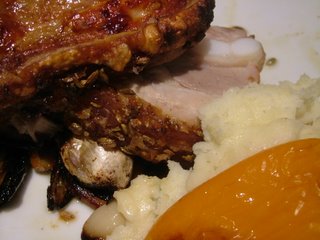 I served this with mashed potato and sweet red and yellow, pointed peppers which I grilled in a griddle-pan on the top of the oven, mixing the juice from the peppers with the pork’s pan juices to make a kind of gravy. Rich and delicious.
I served this with mashed potato and sweet red and yellow, pointed peppers which I grilled in a griddle-pan on the top of the oven, mixing the juice from the peppers with the pork’s pan juices to make a kind of gravy. Rich and delicious.
Crisp sauteed potatoes with speck
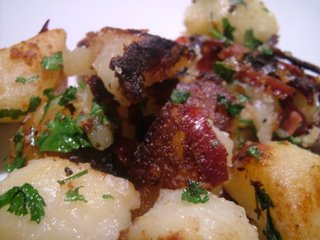 King Edward potatoes are in the shops at the moment; they’re my very favourite potato for frying and roasting flavour and texture. Extremely floury, they roast and saute to a beautiful crisp, and they also mash beautifully.
King Edward potatoes are in the shops at the moment; they’re my very favourite potato for frying and roasting flavour and texture. Extremely floury, they roast and saute to a beautiful crisp, and they also mash beautifully.
Speck is a smoked, raw ham from northern Italy. It can be eaten raw like prosciutto, but it also cooks to a glassy crispiness like a very superior bacon. It’s usually in the delicatessen section of the supermarket; one small pack is plenty in this dish.
To serve two, you’ll need:
6 King Edward potatoes, peeled and cut into chunks
6 slices Speck
2 tablespoons duck or goose fat
2 tablespoons chopped parsley
Salt and pepper to taste
Simmer the potatoes for ten minutes, until they are soft enough to push a knife through. Melt the fat in a large saute pan, and throw in the potatoes and Speck. Saute over a medium heat for twenty minutes, turning regularly until the potatoes are crusty and brown and the Speck is frizzled and crisp.
Stir in the parsley, salt and pepper away from the heat and serve immediately.
The duck or goose fat is important here. No other fat I’ve tried (it should be noted that Jeffrey Steingarten has a soft spot for horse fat – sadly unavailable in the UK) will result in the friable golden crisp that duck or goose fat gives. If you’ve made your own by roasting a duck and draining the tray, so much the better; the fat will be flavourful and will carry the scent of all the herbs and garlic you cooked the duck with.
Steenbergs organic herbs and spices
 I missed my Mum and Dad an awful lot when I was on holiday. Looks like they missed me too; I came home to a present from them – a beautiful little box of sample-sized herbs, salts and spices from Steenbergs.
I missed my Mum and Dad an awful lot when I was on holiday. Looks like they missed me too; I came home to a present from them – a beautiful little box of sample-sized herbs, salts and spices from Steenbergs.
Steenbergs is a Fair Trade and organic supplier of herbs, spices and teas. Their products are available by mail order and in shops in the UK and overseas, and if you’ve an opportunity to try one of their herb or spice sets, I’d recommend you give them a whirl. The little glass jars are full of an eclectic mix of spices from the familiar to the downright exotic, and the company also mixes its own blends, a couple of which were in my little box.
This set includes a nutmeg; an American barbecue mix; three colours of peppercorn (I have been a big fan of pink peppers since my brother bought me a jar to accompany the foie gras he gave us for Christmas); Steenbergs’ ‘perfect salt’; Turkish rosemary (I’m not so sure about this; I find dried rosemary a bit spiky to be useful normally. I’ll have to cook with it and report back); French rose petals; a pink, volcanic Hawaiian salt which I’ll use on more foie gras; and star anise. After a few hours of unscrewing lids and sniffing, screwing them back on, unscrewing them again to have another sniff, screwing them on etc. etc., I decided to give the ‘perfect salt’ a spin.
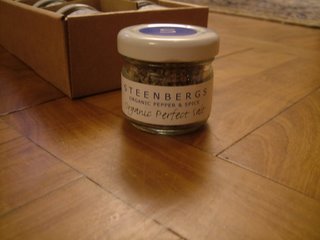 Perfect salt is a herb mix with cracked black pepper in sea salt. Everything (as is the norm with Steenbergs) is organic, and this salt is perfectly balanced. I slathered it all over a duck and put it in an oven for an hour and a half with no other seasoning (not even my traditional lemon) – savoury and delicious. Try it on a roast chicken, on baked vegetables and as a seasoning on finished foods. These blends are simple, natural and well thought-out; the smoke flavour in the barbecue mix comes from Spanish smoked paprika, rather than from smoke flavourings.
Perfect salt is a herb mix with cracked black pepper in sea salt. Everything (as is the norm with Steenbergs) is organic, and this salt is perfectly balanced. I slathered it all over a duck and put it in an oven for an hour and a half with no other seasoning (not even my traditional lemon) – savoury and delicious. Try it on a roast chicken, on baked vegetables and as a seasoning on finished foods. These blends are simple, natural and well thought-out; the smoke flavour in the barbecue mix comes from Spanish smoked paprika, rather than from smoke flavourings.
What is it about the sort of natural, pared-down design that Steenbergs use in their products that makes me so downright hungry?
Fresh Ketch Restaurant, Tahoe Keys Marina
 It might be a mile above sea level and a hundred miles from the coast, but Lake Tahoe has a sprinkling of accomplished seafood restaurants. Fresh Ketch, a few miles’ drive from the casinos at the Stateline on the South Shore, is an elegant restaurant on a private marina, overlooking the blue lake.
It might be a mile above sea level and a hundred miles from the coast, but Lake Tahoe has a sprinkling of accomplished seafood restaurants. Fresh Ketch, a few miles’ drive from the casinos at the Stateline on the South Shore, is an elegant restaurant on a private marina, overlooking the blue lake.
The menu offers a wide selection of seafoods alongside meat and vegetarian dishes. A ‘Treasures from the sea’ section was full of selections with special ingredients, to have instead of one of the excellent starters. Green-lipped mussel fritters, oysters on the half shell, a scallop and spinach gratin and a little dish of clams all jostled for attention. I opted for the clams.
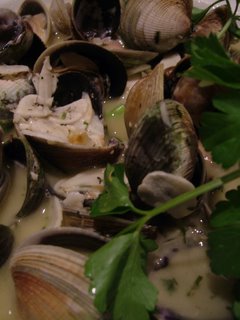 These were fresh New Zealand clams, in a broth of white wine, garlic, herbs and butter. They were delicate and scented; the waiter very thoughtfully brought an extra utensil for Mr Weasel, who was enjoying a hot-smoked trout salad. We mopped up the rich broth with bread. This was a promising start to the meal.
These were fresh New Zealand clams, in a broth of white wine, garlic, herbs and butter. They were delicate and scented; the waiter very thoughtfully brought an extra utensil for Mr Weasel, who was enjoying a hot-smoked trout salad. We mopped up the rich broth with bread. This was a promising start to the meal.
Skiing all day is a killer. It’ll do peculiar things to your appetite, convincing you that what you really, really need is a chunk of protein the size of your head. I don’t do my best ordering when I’ve spend the day skiing, and given the choice available (King crab, Ahi tuna, Tilapia) I should, if I’d had my head screwed on properly, have ordered some of the excellent fish. I didn’t. I asked for an Angus filet. Fortunately for me, it was a beautiful piece of meat, perfectly cooked. (One of my favourite things about dining in America is the ease you have in ordering a steak. Steaks you order rare actually come rare; in England, asking for a rare steak is a gamble. You’ll either end up with something so raw it’s still twitching, or a greying lump of cooked-solid tissue.)
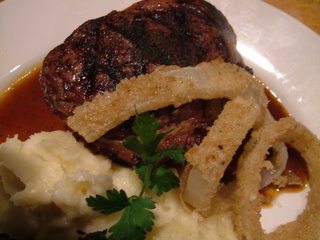 The steak was wrapped in a piece of pancetta, served with a port and shallot jus and garnished with the great American onion ring. I love onion rings, and this was a fine example; soft and sweet inside, and crisp outside, with a golden shell of crumbs. The steak was well-hung and tender.
The steak was wrapped in a piece of pancetta, served with a port and shallot jus and garnished with the great American onion ring. I love onion rings, and this was a fine example; soft and sweet inside, and crisp outside, with a golden shell of crumbs. The steak was well-hung and tender.
Mr Weasel’s main course was that day’s special; Albacore with a mango salsa. Delicious.
The food was so good we were compelled to finish everything on our plates. These being American-sized portions, we were barely able to move by the time we finished the main course, and didn’t make it as far as dessert. We’ll make the effort to go back next year and save some room for pudding.
Coleslaw
Mr Weasel really should know better by now. It’s been nearly ten years; surely that’s enough time to realise that saying such a thing could only have one possible result?
I made some coleslaw.
You’ll need:
¼ celeleriac, peeled
5 carrots, peeled
¼ white cabbage
2 tablespoons double cream
2 tablespoons mayonnaise (make it yourself or use Hellman’s – I’ve still not found another I’ll allow fridge space)
Juice of 1 lemon
1 teaspoon toasted caraway seeds
2 teaspoons walnut oil
½ teaspoon sugar
Salt and pepper
Julienne (cut into fine strips) all the vegetables. This will be infinitely easier if you own a mandoline or a food processor with the relevant blade. The rest of the recipe is simplicity itself – just mix the lot together in a big bowl. Taste to see if you need more lemon, salt or sugar. Then serve immediately.
The idea with coleslaw is that it should be creamy and fresh. It’s really not good if you leave it hanging around (like supermarket or fast food coleslaw); it needs its crunch. This means that it doesn’t make for good leftovers. This will make enough for two people. Swap the mayonnaise for Greek yoghurt if you want a slightly lighter texture.
Mr Weasel’s verdict? He finished his bowl in under a minute, wiped his mouth and said:
“Is there any more?”
Caesar salad
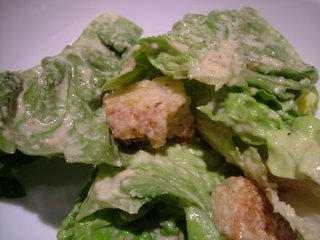 Poor Mr Weasel. While we were in America he fell in love with the Caesar salad at Friday’s Station, the steak house at the top of Harrah’s casino in Heavenly, Tahoe. (Review coming soon.) He’s been mentioning it with a hopeful glint in his eye since we came home.
Poor Mr Weasel. While we were in America he fell in love with the Caesar salad at Friday’s Station, the steak house at the top of Harrah’s casino in Heavenly, Tahoe. (Review coming soon.) He’s been mentioning it with a hopeful glint in his eye since we came home.
He’s had a bad day – he’s had to take the cats to the vet to be neutered. (Not moment too soon; Raffles has been demonstrating some pretty remarkable feats of anatomy since we came back from holiday, and has also become rather territorial, facing off with the new fridge and posturing in a macho fashion around visitors and delivery-men.) Mooncake is being surprisingly bouncy for someone who’s just had her ovaries whipped out and half her fur shaved off. I think this is what comes of not having a pelvic floor. Here they are, Mooncake in the front, demonstrating her newly shaved beard.
 The whole thing was clearly rather stressful for Mr Weasel, who currently seems unable to look the emasculated Raffles in the eye. He ran out of the house at five o’clock under the pretext of going to a friend’s house to do some analogue electronics. I took the opportunity to try to reproduce the salad as a surprise for his dinner.
The whole thing was clearly rather stressful for Mr Weasel, who currently seems unable to look the emasculated Raffles in the eye. He ran out of the house at five o’clock under the pretext of going to a friend’s house to do some analogue electronics. I took the opportunity to try to reproduce the salad as a surprise for his dinner.
Caesar salad is named for Caesar Cardini, the Italian chef working in Mexico who came up with the recipe in the 1920s. A Caesar salad in some American restaurants can be quite a performance, with the dressing being whipped up at the side of the table (Judy Garland fans will be familiar with this from Easter Parade, an otherwise marvellous film which reaches a nadir in the scene where a particularly odious French waiter prepares a Caesar-type salad in mime). I am lazy and use the Magimix.
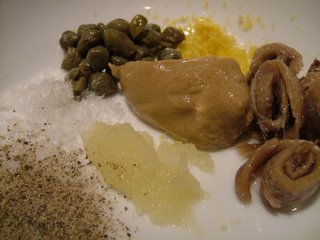 The original recipe does not include anchovies, but the delicious salad from Friday’s Station had them in the dressing, and you’ll find them in my recipe. You’ll need:
The original recipe does not include anchovies, but the delicious salad from Friday’s Station had them in the dressing, and you’ll find them in my recipe. You’ll need:
Croutons
1 soup bowl of bread cut into cubes about 2cm per side
4 grated cloves garlic
1 handful grated parmesan
2 tablespoons olive oil
Dressing
Zest and juice of 1 lemon
1 large clove of garlic, crushed
1 teaspoon Dijon mustard
1 teaspoon Worcestershire sauce
1 teaspoon capers, rinsed
5 anchovies
1 coddled egg (put the egg in briskly boiling water for 60 seconds, then fish out and leave to cool)
1 tablespoon double cream
Salt and pepper to taste
100ml extra-virgin olive oil
1 handful grated parmesan
2 cos lettuces, torn into pieces
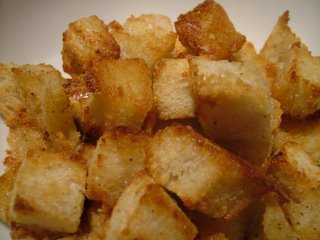 Start by making the croutons. Mix all the ingredients in a large bowl, spread them in one layer on a baking sheet, and bake at 200°C until golden (about ten minutes – keep an eye on them from eight minutes in to check that they don’t over-colour). Set aside.
Start by making the croutons. Mix all the ingredients in a large bowl, spread them in one layer on a baking sheet, and bake at 200°C until golden (about ten minutes – keep an eye on them from eight minutes in to check that they don’t over-colour). Set aside.
Put all the dressing ingredients except the olive oil and parmesan in the bowl of a food processor and whizz until you have a smooth paste. With the machine on and the blades spinning, drizzle the olive oil into the mixture – it will emulsify with the other ingredients and create a creamy dressing.
Toss the lettuce and croutons with the dressing and parmesan. Serve immediately so the croutons and leaves don’t go soggy. Guzzle, and congratulate yourself that it’s not necessary to cross the Atlantic to get a good Caesar salad.
Samurai Sushi Restaurant, South Lake Tahoe
This is the 100th post on this blog. If you’re a lurker who hasn’t popped up and said hello in the comments section before, please do – it’s always good to feel that people I’m not related to read this!
It would not be an exaggeration to say that a large part of our reasoning behind going skiing every year in Heavenly, on the California/Nevada border at South Lake Tahoe, has to do with the presence of the very best sushi restaurant I’ve ever been to. A disclaimer here; I have never been to Japan. I have, however, been to cities all over the world boasting large Japanese populations, and not one of them has been able to serve me sushi this good.
 Lake Tahoe (as clear, clean and blue as it looks in these pictures) is about 200 miles from San Francisco and its enormous fishing docks. Samurai Restaurant (2588 Highway 50, South Lake Tahoe, CA, 530-542-0300) is insistent on the freshness of the fish served – as it says on the menu, if it’s not fresh, they don’t have it. This means that on certain days not everything on the menu will be available, but the choice offered is enormous, and whatever is available is guaranteed to be excellent. The owner, prides himself on the restaurant’s Japanese chefs, all trained for years to produce perfect bullets of rice, seasoned with vinegar he prepares himself, and topped with perfectly cut, perfectly fresh fish. The waiters and waitresses bend over backwards to help and answer questions about the food, and the restaurant itself is a little oasis of quietly decorated peacefulness on the busy Highway 50.
Lake Tahoe (as clear, clean and blue as it looks in these pictures) is about 200 miles from San Francisco and its enormous fishing docks. Samurai Restaurant (2588 Highway 50, South Lake Tahoe, CA, 530-542-0300) is insistent on the freshness of the fish served – as it says on the menu, if it’s not fresh, they don’t have it. This means that on certain days not everything on the menu will be available, but the choice offered is enormous, and whatever is available is guaranteed to be excellent. The owner, prides himself on the restaurant’s Japanese chefs, all trained for years to produce perfect bullets of rice, seasoned with vinegar he prepares himself, and topped with perfectly cut, perfectly fresh fish. The waiters and waitresses bend over backwards to help and answer questions about the food, and the restaurant itself is a little oasis of quietly decorated peacefulness on the busy Highway 50.
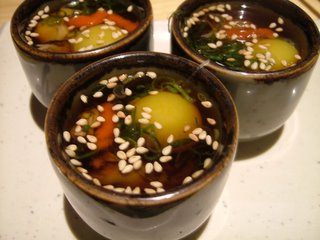 A starter section offers a number of non-sushi options, including an exceptionally good Agedashi Tofu (tofu in a thin, crisp rice-flour coating and a dashi sauce), a flavourful beef rib in a teriyaki-type glossy sauce, and these oyster shooters. Each little sake cup contains a shucked oyster and its juices, a little rice wine vinegar, a raw quail egg, spring onion, toasted sesame seeds and chilis. It’s a rich and flavourful mouthful, to be tipped straight from the cup onto a waiting tongue and tasted thoughtfully.
A starter section offers a number of non-sushi options, including an exceptionally good Agedashi Tofu (tofu in a thin, crisp rice-flour coating and a dashi sauce), a flavourful beef rib in a teriyaki-type glossy sauce, and these oyster shooters. Each little sake cup contains a shucked oyster and its juices, a little rice wine vinegar, a raw quail egg, spring onion, toasted sesame seeds and chilis. It’s a rich and flavourful mouthful, to be tipped straight from the cup onto a waiting tongue and tasted thoughtfully.
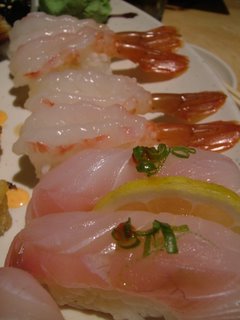 Although we visited a slightly embarrassing four times in two weeks, we didn’t get to the section on the menu with the hot main courses; the sushi is so good that to miss an opportunity to try it would be a real pity. Here you can see some red snapper (in the front of the picture) and Amaebi (sweet prawns) Nigiri. The sushi here is seasoned minutely, to a degree where extra wasabi and soy is barely necessary; each different kind of fish has been prepared with a slightly different seasoning. This snapper takes on a very little flavour from the rind of the lemon separating it, and is adorned with a tiny dab of chili and some of the green part of a spring onion. This chili also makes a perfectly balanced appearance on the albacore tuna Nigiri.
Although we visited a slightly embarrassing four times in two weeks, we didn’t get to the section on the menu with the hot main courses; the sushi is so good that to miss an opportunity to try it would be a real pity. Here you can see some red snapper (in the front of the picture) and Amaebi (sweet prawns) Nigiri. The sushi here is seasoned minutely, to a degree where extra wasabi and soy is barely necessary; each different kind of fish has been prepared with a slightly different seasoning. This snapper takes on a very little flavour from the rind of the lemon separating it, and is adorned with a tiny dab of chili and some of the green part of a spring onion. This chili also makes a perfectly balanced appearance on the albacore tuna Nigiri.
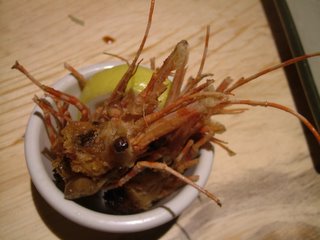 The Amaebi Nigiri is accompanied by the heads of the raw prawns. The heads are deep-fried until so crisp that the whole thing, eyes, beak and all, is edible. They are served with a piece of lemon to squeeze over, and if you are lucky, the people you are eating with will be too squeamish to eat them so you can gobble the lot yourself.
The Amaebi Nigiri is accompanied by the heads of the raw prawns. The heads are deep-fried until so crisp that the whole thing, eyes, beak and all, is edible. They are served with a piece of lemon to squeeze over, and if you are lucky, the people you are eating with will be too squeamish to eat them so you can gobble the lot yourself.
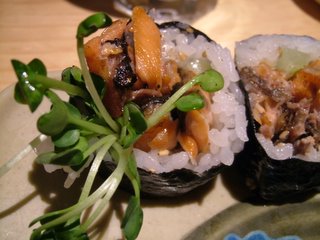 Samurai is on the California side of the lake, so California rolls are mandatory. There’s a large selection of Maki rolls and other, more American offerings. The salmon skin rolls (with what I think are alfalfa sprouts – any alfalfa-familiar readers who can identify these for sure are invited to comment) are crisp and smokily delicious.
Samurai is on the California side of the lake, so California rolls are mandatory. There’s a large selection of Maki rolls and other, more American offerings. The salmon skin rolls (with what I think are alfalfa sprouts – any alfalfa-familiar readers who can identify these for sure are invited to comment) are crisp and smokily delicious.
 House rolls from the large selection on offer – not at present visible on the restaurant’s website – are really, really well worth sampling. The Crabby Crabbington showcases the local King Crab leg with soft-shelled crabs; my favourite, the Crouching Tiger (the bottom roll on the right), is filled with crab and other good things, covered in a tempura batter, then wreathed in prawns and Unagi (more about that later) and its sauce. Above the Crouching Tiger roll you can see Mr Weasel’s favourite, a J-Lo roll, full of avocado, crab and a spiced raw tuna. Fights broke out each time we visited over which rolls to select. Visit with someone of a gentle nature in order to get exactly what you want.
House rolls from the large selection on offer – not at present visible on the restaurant’s website – are really, really well worth sampling. The Crabby Crabbington showcases the local King Crab leg with soft-shelled crabs; my favourite, the Crouching Tiger (the bottom roll on the right), is filled with crab and other good things, covered in a tempura batter, then wreathed in prawns and Unagi (more about that later) and its sauce. Above the Crouching Tiger roll you can see Mr Weasel’s favourite, a J-Lo roll, full of avocado, crab and a spiced raw tuna. Fights broke out each time we visited over which rolls to select. Visit with someone of a gentle nature in order to get exactly what you want.
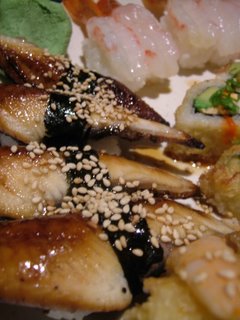 Uni (sea urchin) was firm, sweet and tasted of the sea. Exactly right and beautifully fresh (it’s so disappointingly easy to find restaurants serving ancient, stale Uni, as I did a few months ago). Finally, the Unagi (crisply grilled freshwater eel) here is the very best I’ve tried anywhere. You can watch it being grilled fresh at the sushi bar, and it arrives on your plate hot and crackling. The eel is selected carefully here for a fatty layer beneath the skin which will create that crisp finish when heated quickly. The meat is tender and sweet, and the sauce which is brushed across the top is delicate, finishing the sushi perfectly.
Uni (sea urchin) was firm, sweet and tasted of the sea. Exactly right and beautifully fresh (it’s so disappointingly easy to find restaurants serving ancient, stale Uni, as I did a few months ago). Finally, the Unagi (crisply grilled freshwater eel) here is the very best I’ve tried anywhere. You can watch it being grilled fresh at the sushi bar, and it arrives on your plate hot and crackling. The eel is selected carefully here for a fatty layer beneath the skin which will create that crisp finish when heated quickly. The meat is tender and sweet, and the sauce which is brushed across the top is delicate, finishing the sushi perfectly.
If you get the chance to visit, order adventurously. Try the items on the menu you think you don’t like – you may just never have had them fresh before. If you’re staying in one of the many Stateline hotels, you’ll need to drive or take a cab – the restaurant is about four miles into California, and hopefully you will be too full to walk that distance by the time they’ve finished with you.
Only another year to go.


